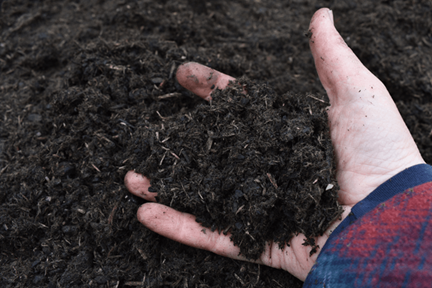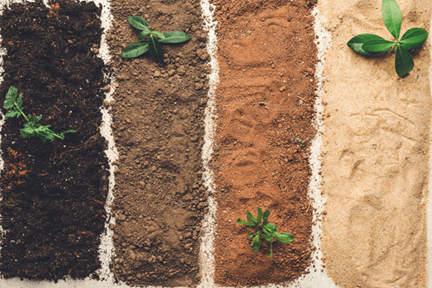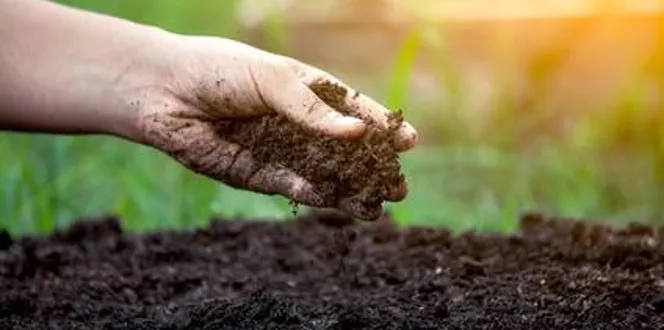The soil in your gardens and landscape beds is the foundation for the health of your plants.
Your poor soil has been through the wringer. Home construction does a number on soil, stripping topsoil and all of its organic matter and nutrients away. On top of that, the compaction that happens over time from foot and vehicle traffic prevents air and water from flowing through the soil layers to your plant roots. On top of that, your plant roots can’t penetrate that tough soil.
Your plant roots need to breathe and grow in order to produce healthy, thriving greenery. And they need organic matter and nutrients.
Spring is the ideal time to take some soil preparation steps to ensure a great growing season for your home landscape.
The Importance Of Understanding Your Soil
Healthy soil helps filter water and nutrients, boosting plant growth, and making your landscape functionally aesthetic.
But to know how to improve soil quality, you have to know what’s in it.
Your soil is made up of mineral components, organic components, water, and gasses (oxygen, carbon dioxide, and nitrogen). The organic components include organisms and their remnants like fungi, insects, and humus. They filter and store nutrients, as well as recycle and release new nutrients.
Depending on your location, there are four soil types:
- Clay soil - A heavier soil, which can benefit from organic fertilizer, mulch, and compost to lighten it by creating a good structure.
 Sandy soil - A light soil that warms quickly in spring but doesn’t retain water or nutrition as well because of its permeability. It also can dry out in the summer, so it needs regular light watering in warm weather. Organic matter helps it with nutrient and water retention.
Sandy soil - A light soil that warms quickly in spring but doesn’t retain water or nutrition as well because of its permeability. It also can dry out in the summer, so it needs regular light watering in warm weather. Organic matter helps it with nutrient and water retention.- Silty soil - While rich and fertile, this soil is sensitive to erosion and benefits from organic matter to improve structure and mulch or groundcover to shield it from weathering.
- Chalky soil - This whitish soil filled with calcium carbonates dries out quickly in warm weather, cracking easily. Since it holds onto nutrients versus circulating them, this can lead to yellowing plant leaves. This soil usually needs organic matter or fertilizer additions, but not extra lime since it’s already present in high quantities.
Why You Should Do A Soil Test
Because soil is so important, the more you know about it, the better.
That’s why performing a soil test is an essential soil preparation step. A soil test can tell you your soil pH, the amount of organic matter in your soil and the levels of nutrients present.
A soil test is a great option if you haven’t had one done in more than 3 years, you just moved to a new home and don’t know anything about your soil, your plants have been struggling, or you wanted to see if some amendments boosted your soil conditions.
You can conduct a soil test through a home and garden store kit or via a professional who sends a sample of your soil to a lab for precise results. Some companies like Davey even do this for free as part of your service.
How To Prepare And Improve Your Soil For Gardening
Now that you know how important soil is, learning how to improve the quality of your garden soil or how to improve soil quality in flower beds is your next step.
There are a few simple things you can do to make a difference.
Clear Out Rocks And Debris
First, you want to remove any large rocks, grass, or debris left in your soil.
Do this by prying these bits out of your soil with a spade and using a hard rake.
Loosen Compacted Soil
Your next soil preparation method is to loosen it.
Use a hoe or tiller to break up the soil to an 8- to 12-inch depth so roots have an easier transition downward. Be careful when working in areas close to trees so as not to damage tree roots.
Remove Any Unwanted Pests
Weed plants and their seeds, pests such as grubs, and soil pathogens are also unwanted in your soil’s composition.
Talk to your local landscape professional or certified arborist about making sure your soil is free of these problems.
Add Soil Amendments

Finally, how do you prepare your garden soil for planting? You add organic matter to it. Composted leaf litter with manure is a great choice. Turf benefits from up to one-quarter inch of compost at a time, while beds can take an inch at a time. Mulch is best when initially installed to two inches deep and then replenished with an additional inch every year.
Most plants prefer a soil pH that is between 6 and 7. So if it’s too high, you’ll want to add sulfur, peat, or organic mulch to lower it. If your soil pH is too low, you want to raise it with lime.
Another approach to improving your soil is adding biochar, which is fine-grained charcoal that is created by slowly burning wood and agricultural byproducts like plant matter.
Biochar is more stable than compost and helps soils resist becoming compacted.
Watch this short video explaining what biochar is and how it benefits your soil.






